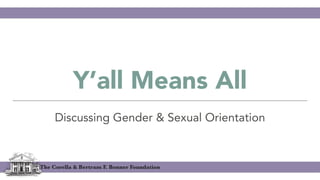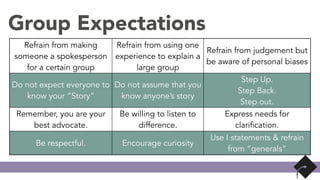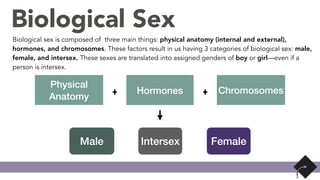Y'all Means All: Discussing Gender and Sexual Orientation
- 1. The Corella & Bertram F. Bonner Foundation Y’all Means All Discussing Gender & Sexual Orientation
- 2. Group Expectations Refrain from making someone a spokesperson for a certain group Refrain from using one experience to explain a large group Refrain from judgement but be aware of personal biases Do not expect everyone to know your “Story” Do not assume that you know anyone’s story Step Up. Step Back. Step out. Remember, you are your best advocate. Be willing to listen to difference. Express needs for clarification. Be respectful. Encourage curiosity Use I statements & refrain from “generals”
- 4. Biological Sex Biological sex is composed of three main things: physical anatomy (internal and external), hormones, and chromosomes. These factors result in us having 3 categories of biological sex: male, female, and intersex. These sexes are translated into assigned genders of boy or girl—even if a person is intersex. Physical Anatomy Hormones Chromosomes Male Intersex Female
- 5. Gender IdentityYour gender identity is how you feel inside and how you express those feelings. Clothing, appearance, and behaviors can all be forms of gender expression—ways to express your gender identity. If your gender identity feels in harmony with your biological sex, you are considered cisgender. If your gender identity does not feel in harmony with your biological sex, or with the idea of being “a man” or “a woman,” you may identify with different genders, including: transgender, genderqueer, gender fluid, agender, non-binary, or non gender confirming. It is always important to ask someone about their pronouns so that you use the correct ones when referring to them.
- 6. Sexual Orientation Sexual orientation is about who you’re attracted to and who you feel drawn to romantically, emotionally, and/or sexually. These attractions can define a person’s sexual orientation as homosexual, heterosexual, bisexual, pansexual, queer, or asexual.
- 8. Debrief Reflection Questions: • Initial thoughts or reactions to what we’ve discussed so far? • Did you learn a new definition? If so, which one? • Did you struggle with any of the concepts discussed? If so, why? • What is one way you can apply this newly learned information? • Was the matching activity difficult for you? If so, why? • Gender is something that everyone thinks they know and/or understand. However, we just explored how complex the language used to talk about gender really is. Why do you think that gender is rarely discussed in its full complexity?
- 9. Issue Briefs Log on to Kahoot.It
- 10. Things to Do • Acknowledge that “ally” is not an identity. • Check your privilege at all times. • Do not assume the sexual orientation or gender identity of another person. • Speak out against offensive statements or actions you see or hear. • Use gender non-specific language, like “partner” instead of “boyfriend” or “girlfriend.” • Respect the coming out process, and understand that some information may be off limits. • Know that your opinion takes a backseat to those with experience. • Listen when someone opens up about their experience. • Validate people’s sexual orientation and gender expression. If a person shares preferred pronouns with you, be intentional about using them, even when they aren’t in the room. If someone tells you about their same-sex partner, ask about their relationship like you would a straight friend’s. • Educate yourself about LGBT histories, cultures, and concerns. • Involve yourself/support LGBT organizations and causes. How To Be An Ally?
- 11. Educate Yourself • Understand that knowing marginalized people ≠ being inclusive • Be honest about things you don’t understand—don’t try to fake it! Respectful questions are generally better than making assumptions about someone’s identity. • A person’s gender identity is different than a person’s sexual orientation. • When someone comes out, it does not mean they are sexually attracted to you. • Do not ‘out’ a person as LGBTQ to others. Respect people’s privacy and recognize that it should be their decision when and with whom to share their LGBT identity. • The transition experience is different for each trans person. • Be aware of the vital role you can play as an ally. • Remember the intricacies of oppression. How To Be An Ally?
- 12. •Initial thoughts and/or reactions? •Did you find any of these actions difficult? Easy? •What is one issue you would like to see changed in your lifetime? •What is one way (not listed on the handout) you can be an ally and see the change you desire to see? •What is one way you can apply the knowledge you learned from this training in real life? Ally Reflection Questions












